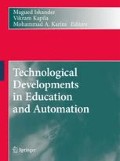Abstract
The paper concentrates on the life-long education. The rapidly changing world is a challenge for both individuals and states as the performance of the work-force is one of the most important factors of any state’s long term success in both financial and social sectors. The paper proposes an e-education system that should be funded by the state and exposed to all citizens in order to constantly upgrade their skills. It is a state service targeted to individuals of different ages as an alternative to the massive education targeted exclusively to the young people. The paper also outlines the model of such system and suggests the way it can be built.
Access this chapter
Tax calculation will be finalised at checkout
Purchases are for personal use only
Preview
Unable to display preview. Download preview PDF.
References
D. Mowery, R. Nelson, B. Sampat, and A. Ziedonis, “Ivory Tower and Industrial Innovation,” Stanford Business Books, California: Stanford, 2004.
K. Fischer, “The university as economic savior: as higher education replaces industry in some cities, colleges face both support and unrealistic expectations,” Chronicle of Higher Education, 2007.
J. Youtie, and P. Shapira, “Building an innovation hub: A case study of the transformation of university roles in regional technological and economic development,” Research policy, vol. 37 (8), pp. 1188-1204, 2008.
D. S. Siegel, D. A. Waldman, L. E. Atwater, and A. N. Link, “Toward a model of the effective transfer of scientific knowledge from academicians to practitioners: qualitative evidence from the commercialization of university technologies,” J. of Engineering and Technology Management, vol. 21(1-2), pp. 115-142, 2004.
B. Readings, Education / Teaching, Harvard University Press, 1997.
E. González-Agulla, E. Argones-Rúa, C. García-Mateo, and Ó W. M. Flórez, “Development and Implementation of a Biometric Verification System for E-learning Platforms,” EDUTECH, Computer-Aided Design Meets Computer-Aided Learning, IFIP 18th World Computer Congress, 2004, pp. 155-164.
O. Guven, S. Akyokus, M. Uysal, and A. Guven, “Enhanced password authentication through keystroke typing characteristics,” Proceedings of the 25th conference on Proceedings of the 25th IASTED International Multi-Conference: artificial intelligence and applications, 2007, pp. 317-322.
A. K. Jain, A. Ross, and S. Prabhakar, "An Introduction to Biometric Recognition," IEEE Trans. on Circuits and Systems for Video Technology, vol. 14 (1), 2004, pp 4-19.
A. K. Jain, L. Hong, and S. Pankanti, “Biometric Identification,” Communications of ACM, vol. 43 (2), 2000, pp. 91-98.
D. Kumlander, “Soft Biometrical Students Identification Method for e-Learning,” in Advances in Computer and Information Sciences and Engineering, Springer, Netherlands, 2008, p. 114 – 118.
Author information
Authors and Affiliations
Corresponding author
Editor information
Editors and Affiliations
Rights and permissions
Copyright information
© 2010 Springer Science+Business Media B.V.
About this paper
Cite this paper
Kumlander, D. (2010). e-Education as a State Service to Citizens of Different Ages. In: Iskander, M., Kapila, V., Karim, M. (eds) Technological Developments in Education and Automation. Springer, Dordrecht. https://doi.org/10.1007/978-90-481-3656-8_83
Download citation
DOI: https://doi.org/10.1007/978-90-481-3656-8_83
Published:
Publisher Name: Springer, Dordrecht
Print ISBN: 978-90-481-3655-1
Online ISBN: 978-90-481-3656-8
eBook Packages: Humanities, Social Sciences and LawEducation (R0)

